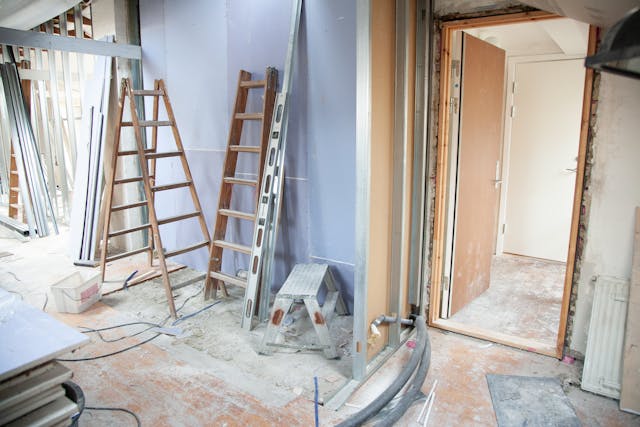Renovating your home is exciting, but it’s also one of the easiest ways to burn through cash if you’re not careful. Mistakes can add up fast, leading to costly repairs, wasted materials, and even long-term damage to your property. If you want to avoid expensive regrets, here are ten common home renovation mistakes that could cost you thousands.
Table of Contents
1. Poor Quality Flooring
Cutting corners on flooring might seem like a budget-friendly decision at first, but it often leads to expensive repairs or full replacements sooner than expected. Cheap materials wear down quickly, scratch easily, and can even become safety hazards if they start lifting or cracking. Poor installation is just as bad—improperly laid flooring can warp, shift, or cause moisture issues. Instead, invest in high-quality flooring from one of the leading flooring brands and professional installation to ensure durability and longevity.
2. Ignoring Structural Issues
Renovating a home without addressing underlying structural problems is like putting a fresh coat of paint on a crumbling wall—it might look nice for a while, but the problems will only get worse. Issues like foundation cracks, sagging floors, or rotting beams should be handled before any cosmetic upgrades. Ignoring them can lead to severe (and expensive) damage down the line.
3. DIY Electrical Work
It’s tempting to handle small electrical projects yourself, but if you’re not a licensed electrician, you’re taking a huge risk. Faulty wiring can cause power failures, damage expensive appliances, and, worst of all, create a serious fire hazard. Even if it “works,” shoddy electrical work could result in costly fines or force you to redo everything to meet building codes. Always hire a professional for electrical upgrades.
4. Not Budgeting for Unexpected Costs
No matter how well you plan, surprises will happen. Hidden mold, outdated wiring, or even material price hikes can throw your budget off track. If you don’t leave room for these unexpected costs, you might find yourself cutting corners or running out of money before the project is complete. A good rule of thumb is to set aside at least 20% of your total renovation budget for surprises.
5. Choosing Trendy Over Timeless
Trends come and go, but home renovations should last. That bold wallpaper or ultra-modern kitchen might look stylish today, but will it still look good in five years? Making design choices based solely on current trends can make your home feel outdated quickly, potentially affecting resale value. Instead, go for classic styles and use trends in smaller, easier-to-update details like paint or décor.
6. Skipping Permits and Inspections
Cutting corners on permits and inspections is a mistake that could cost you more than just money—it can lead to legal issues, fines, and even having to tear down completed work. Many renovations require approval, especially if they involve structural changes, electrical work, or plumbing. Skipping this step could also make it harder to sell your home in the future, as buyers may demand proof that all work was done legally.
7. Poorly Planned Layout Changes
Tearing down walls or reconfiguring spaces might seem like a great idea, but without proper planning, it can lead to major issues. A poorly thought-out layout can affect everything from natural light to heating efficiency. For example, removing a wall might leave you with an awkward space that doesn’t function well, while relocating plumbing can add unnecessary costs. Before making layout changes, consider how the space will be used and consult a professional if needed.
8. Underestimating the Importance of Good Lighting
Lighting can completely change the look and feel of a home, yet it’s often an afterthought in renovations. Relying on a single overhead light or failing to incorporate natural light can leave rooms feeling dim and uninviting. Good lighting design includes a mix of ambient, task, and accent lighting to enhance both functionality and aesthetics. Consider adding recessed lighting, under-cabinet lights, or larger windows to brighten up your space.
9. Overlooking Proper Ventilation
Ventilation isn’t the most exciting part of a renovation, but it’s crucial for maintaining air quality and preventing long-term damage. Poor ventilation in areas like bathrooms and kitchens can lead to mold, mildew, and excessive moisture, which can damage walls, cabinets, and even structural elements. Investing in proper ventilation, like exhaust fans and well-placed windows, can save you from expensive repairs later.
10. Hiring the Wrong Contractors
A bad contractor can turn your dream renovation into a nightmare. Whether it’s poor craftsmanship, missed deadlines, or disappearing with your deposit, hiring the wrong team can lead to serious financial headaches. Instead of choosing the cheapest option, do your research—read reviews, ask for references, and check credentials. A reputable contractor might cost more upfront, but the peace of mind and quality work are worth it.
Plan Smart to Save Big
Home renovations are a big investment, but avoiding these costly mistakes can make all the difference. Taking the time to plan properly, invest in quality materials, and hire the right professionals will save you money in the long run. A well-executed renovation not only adds value to your home but also makes it a more enjoyable place to live.

